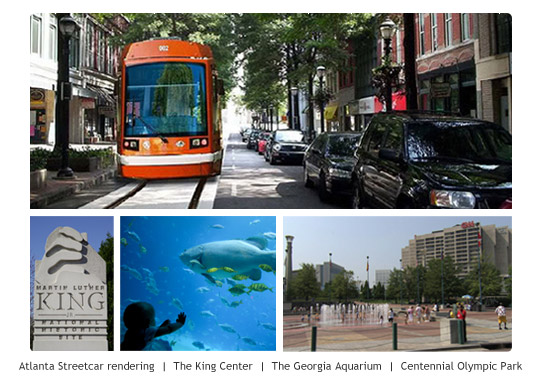
|
|
Great things are happening in every metro area around the U.S. Metro Atlanta Progress shares exciting regional and local initiatives that are making a difference in our area and that might spark other ideas. We invite readers from other areas of the country to share your innovations and progress with us. We look forward to a rich conversation about the progress we are making in America's metro regions.
|

|
Atlanta Streetcar Rolling Toward Reality
May 2012
Construction of the new 2.6-mile Atlanta Streetcar line broke ground on February 1, 2012. The City of Atlanta received the nation’s largest TIGER II grant from USDOT to build the line that will connect important downtown venues, with future expansions planned.

The Atlanta Streetcar Project will cover much of downtown Atlanta, providing access to many attractions, including the World of Coca-Cola, the Georgia Aquarium, the historic Auburn Avenue corridor including the Martin Luther King Center and five local parks, including Centennial Olympic Park. The streetcar will also ferry riders to several attractions that are currently under construction, including the National Center for Civil and Human Rights and a transit museum.
At a recent press conference, Atlanta Mayor Kasim Reed noted that the funding from Tiger II for this project represents “the largest single federal allocation awarded to the City of Atlanta for transportation outside of Hartsfield-Jackson Airport and MARTA in more than a decade.”
Reed also said the project would transform downtown. His office has estimated the project will create 5,200 jobs over 20 years and will not only help ease downtown traffic problems by providing new connections between business centers, but will also help the city compete for more tourism and convention business by connecting tourist attractions, hotels and restaurants.
The funding for the Streetcar comes from three sources:
- The majority of the money comes from the TIGER II Discretionary Grant totaling $47,667,777.
- Another $15.6 million comes from the City of Atlanta.
- The balance of funds will come from the Atlanta Downtown Improvement District.
In addition, the Atlanta Regional Commission’s Livable Centers Initiative (LCI) has provided $5 million dollars for enhanced streetcar stops and upgrades to pedestrian and bicycle facilities.
The streetcar line will stretch 2.6 miles, making a figure-eight through downtown Atlanta. It will have 12 stations, with cars running every 15 minutes, connecting with the MARTA rapid rail system to many attractions around the area. Passengers will be able to transfer to and from MARTA at no cost and use the electric pay system already in place, making for efficient transfers.
Passengers will ride in the modern S70 Siemens car design. These ADA-compliant cars feature bicycle racks and spaces for wheelchairs. They also feature a low floor and driver stations in the front and back. The cars travel at a maximum speed of 25 to 30 miles per hour.
Read more about the Atlanta Streetcar and its progress…

Connecting the Streetcar to the Beltline as Part of the Regional Transportation Referendum
The Atlanta Regional Transportation Referendum, to be voted on in July, would significantly extend the Tiger II funded streetcar through the urban core, ultimately connecting passengers to the Atlanta Beltline system, currently under construction. The Beltline is a network of public parks, multi-use trails and transit along an historic 22-mile railroad corridor circling downtown and connecting 45 neighborhoods to one another and to business centers.
On July 31, 2012, residents in Cherokee, Clayton, Cobb, DeKalb, Douglas, Fayette, Fulton, Gwinnett, Henry and Rockdale counties have the opportunity to vote on a referendum that would fund $8.5 billion in transportation improvements through a regional one percent sales tax, including $6 million for the extension of the streetcar system.
If the referendum passes, the streetcar will be extended to both the northeast and southwest Atlanta BeltLine corridors. Both projects include the construction of a streetcar line with stations approximately every ½ mile and 10 years of operations and maintenance funding.
The northeast extension would provide access to some of Atlanta’s most walkable neighborhoods, Virginia Highlands and Inman Park, connect to the region’s largest park, Piedmont Park, and to an existing MARTA station in downtown Atlanta. The southwest extension connects the downtown business district with the growing midtown business district, as well as Georgia Tech, the under construction Ponce City Market and several parks and neighborhoods.
The regional transportation referendum includes 51 percent transit and 49 percent roads. It is not only an opportunity to expand our transit system, but it's an opportunity to attract economic development, create jobs and save taxpayers money.
Read more about the Regional Transportation Referendum…
Read more about the Atlanta Beltline…

Atlanta Streetcar Development Strategy
The Atlanta Streetcar project is about more than improving mobility and access. With more than 80 acres of land and many buildings and structures within two blocks of the route considered underutilized, there are significant opportunities for development that will improve the quality of life for residents, employees, visitors, shoppers and students throughout the corridor and provide economic opportunity for businesses.
Central Atlanta Progress and the Atlanta Downtown Improvement District in partnership with the City of Atlanta aim to leverage the federal and municipal investment in the Atlanta Streetcar by encouraging redevelopment along the route of this new transit line in Downtown Atlanta.
Work is underway to ensure that existing plans are consistent with anticipated future land uses and the desires of current property owners, as well as to identify potential limitations or impediments to redevelopment. The next steps are to collaborate with Invest Atlanta to create a toolbox of incentives for developers and to research strategies and tools used in other cities that have recently implemented similar systems.
The end product of this work will be a clear vision and road map to both guide investment in the corridor and proactively encourage its realization.
|